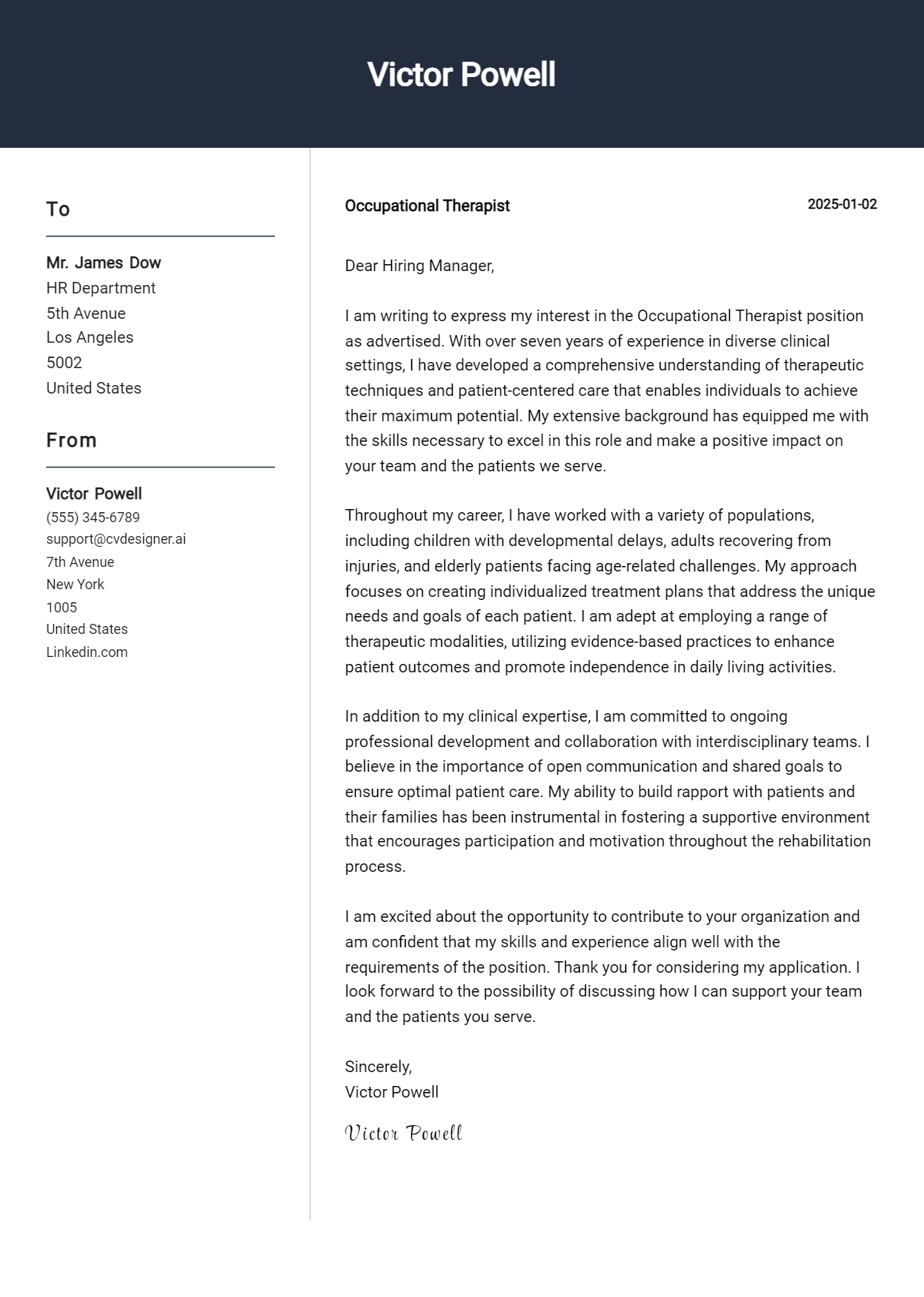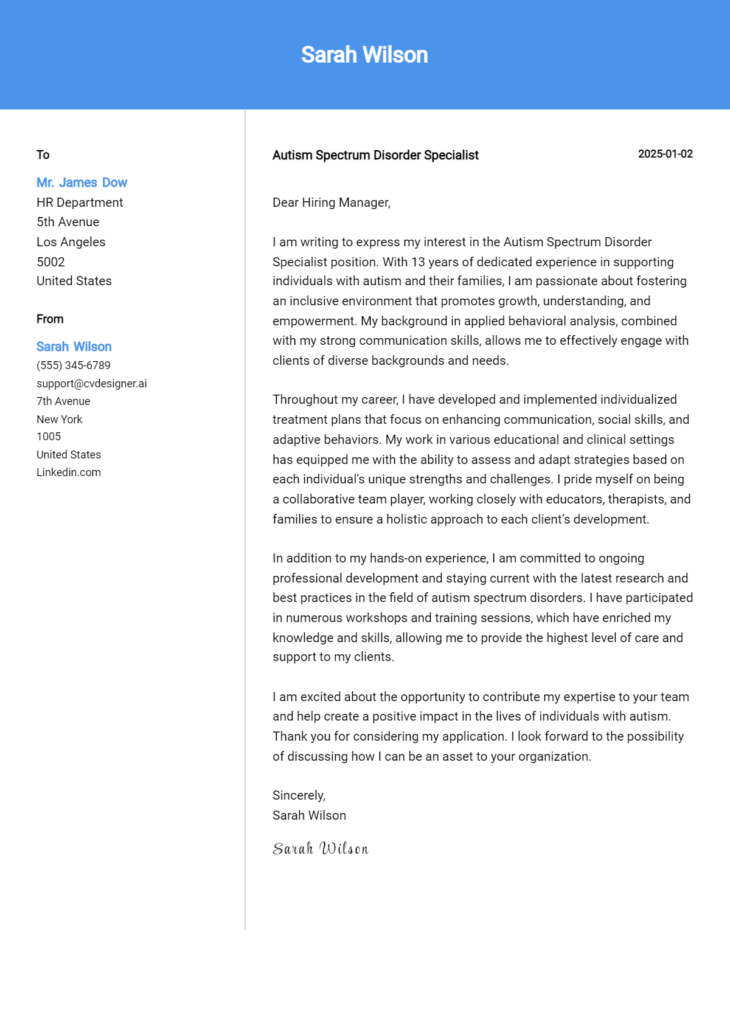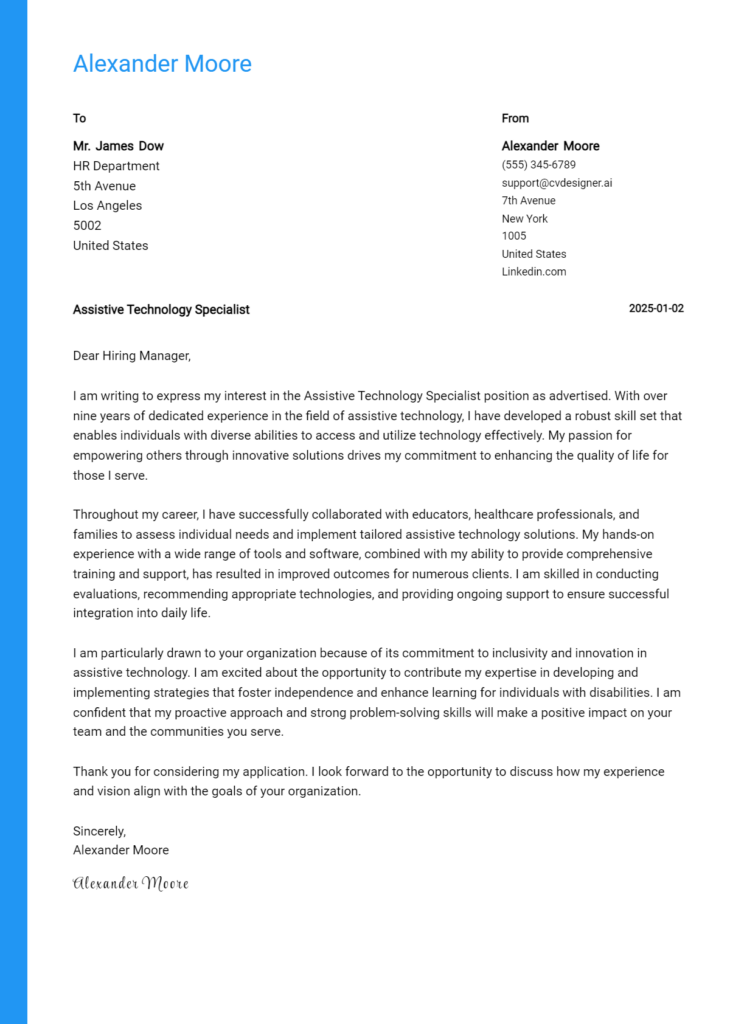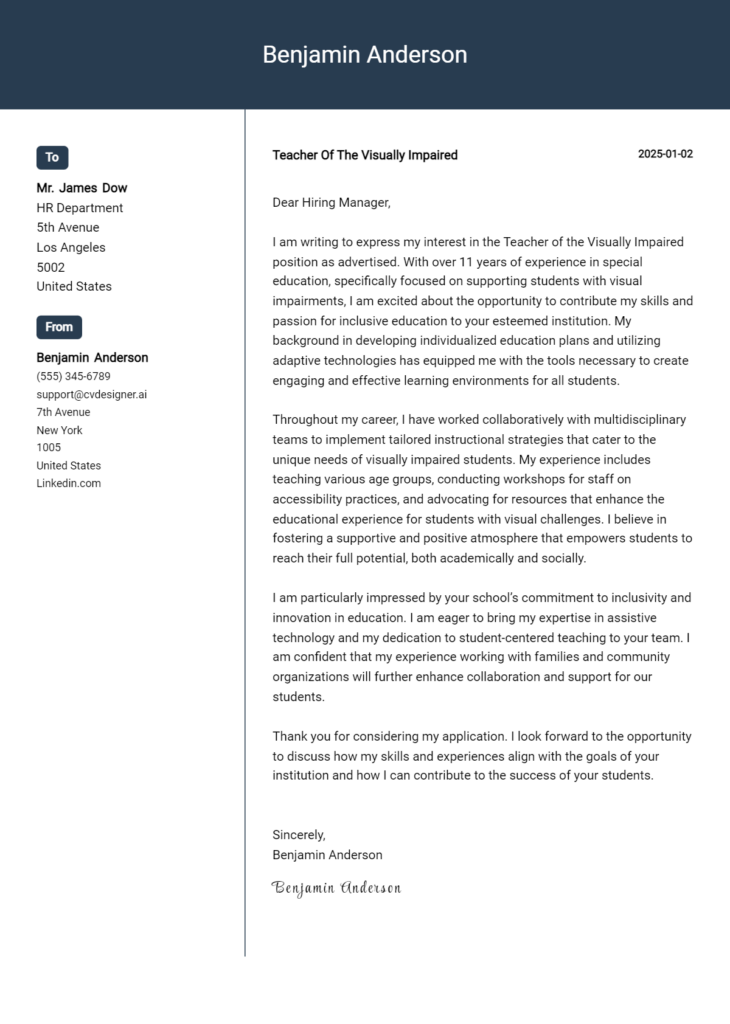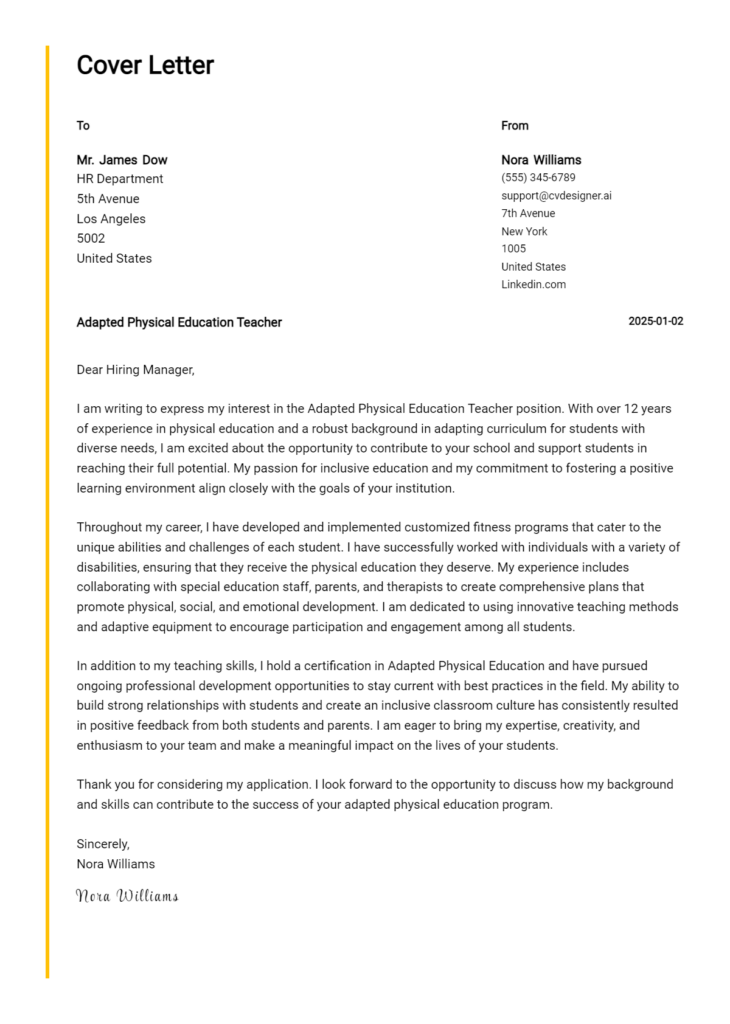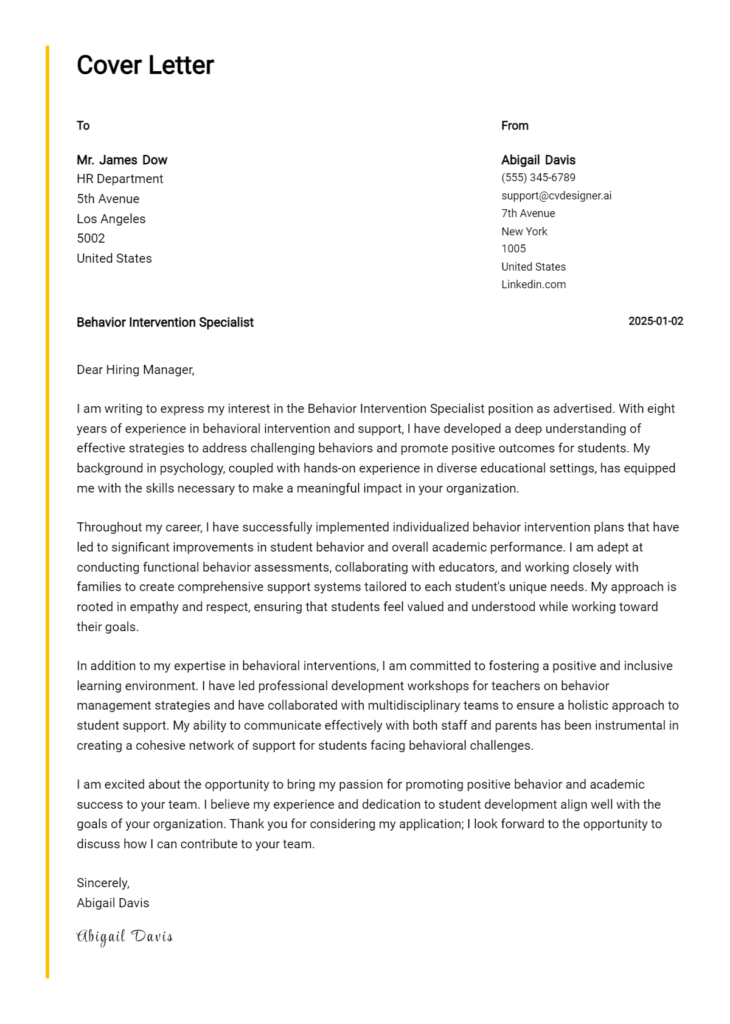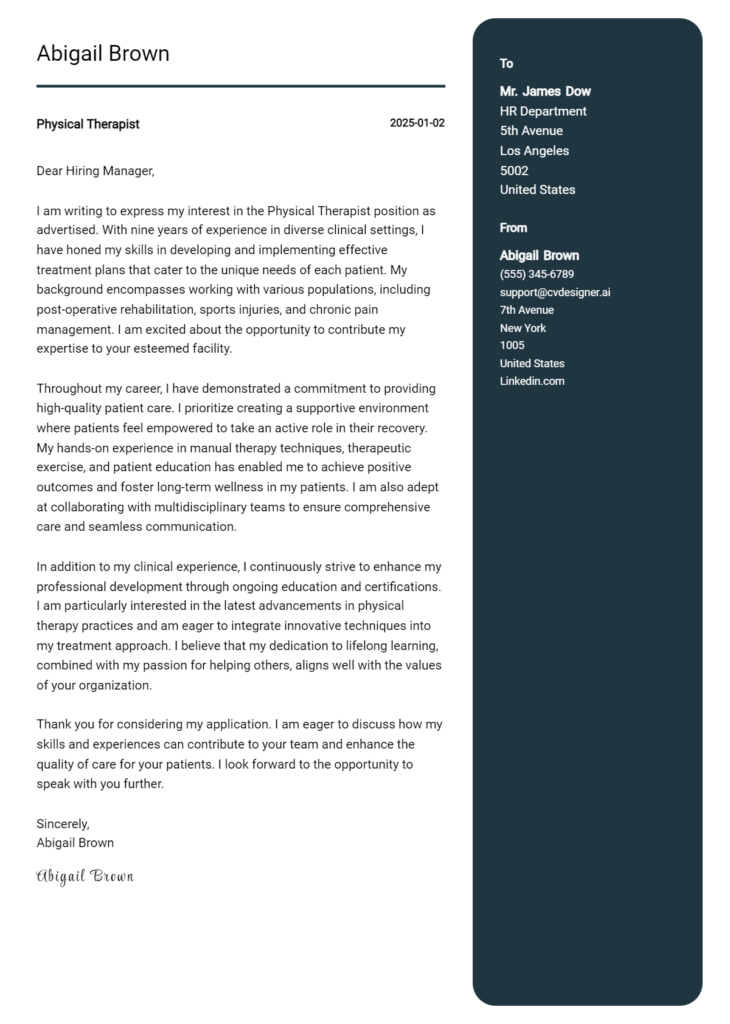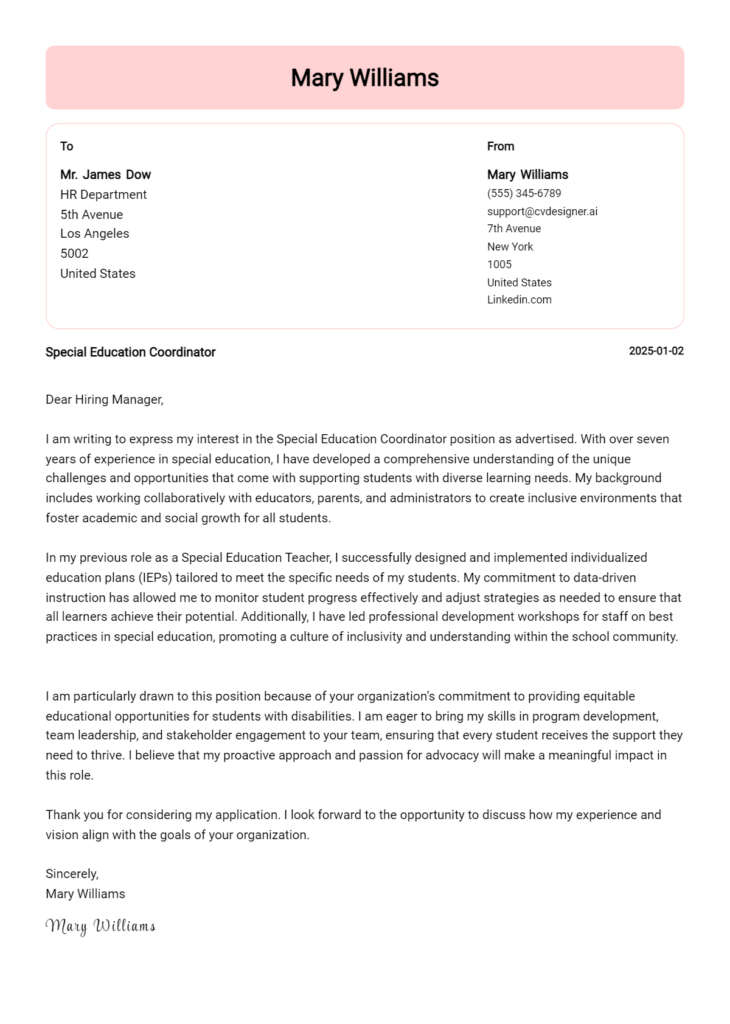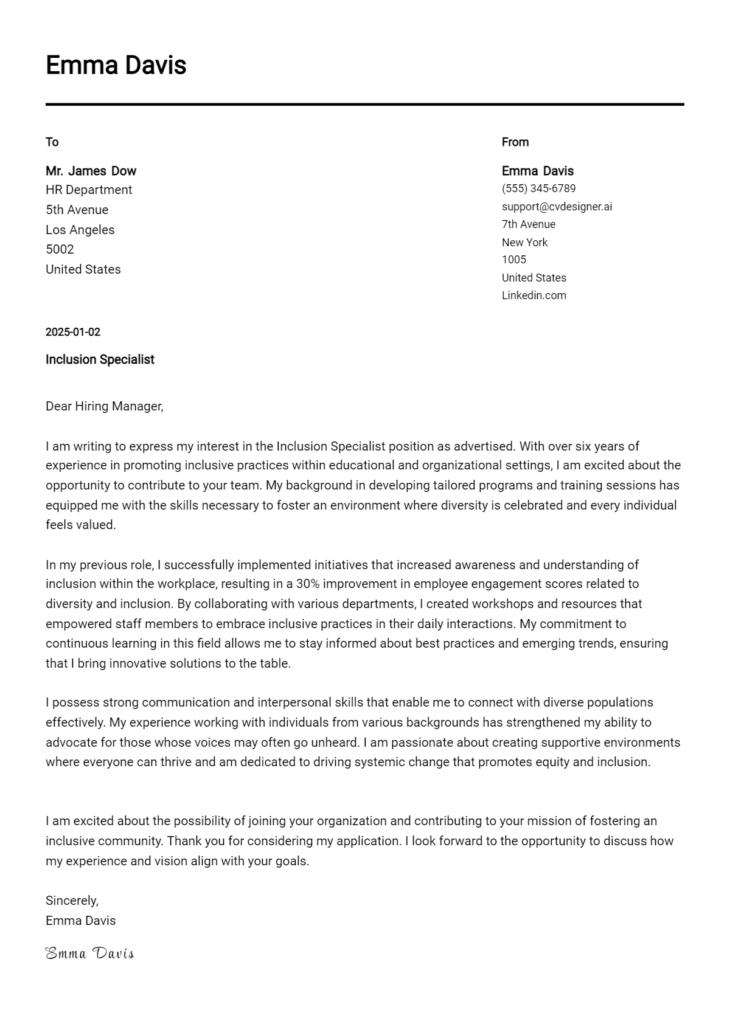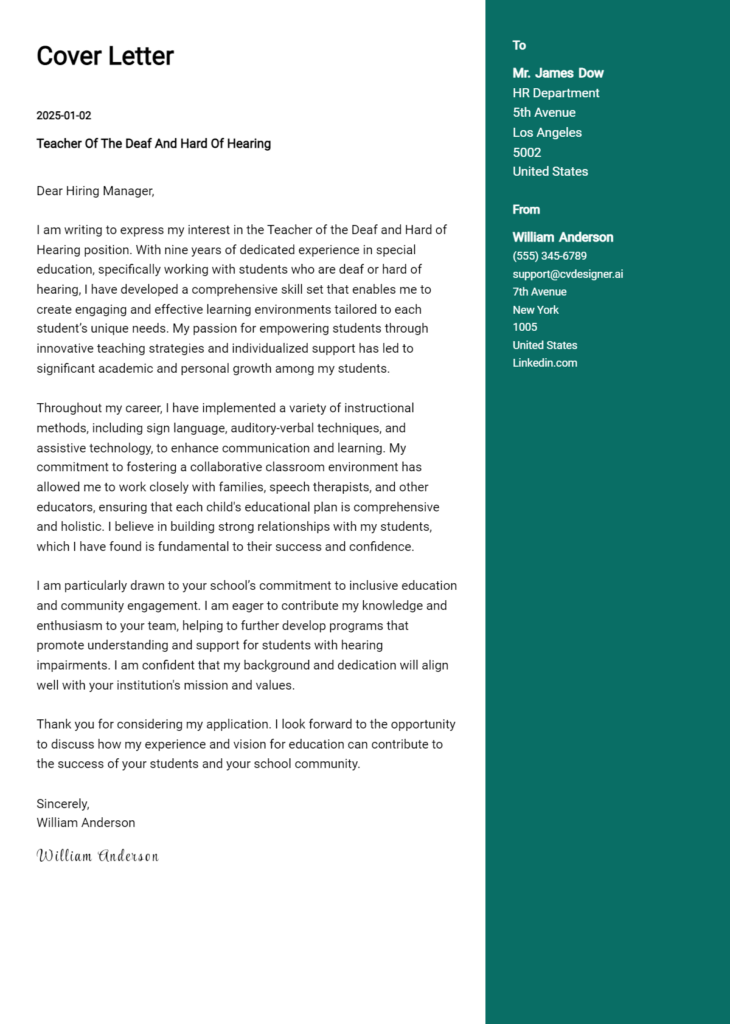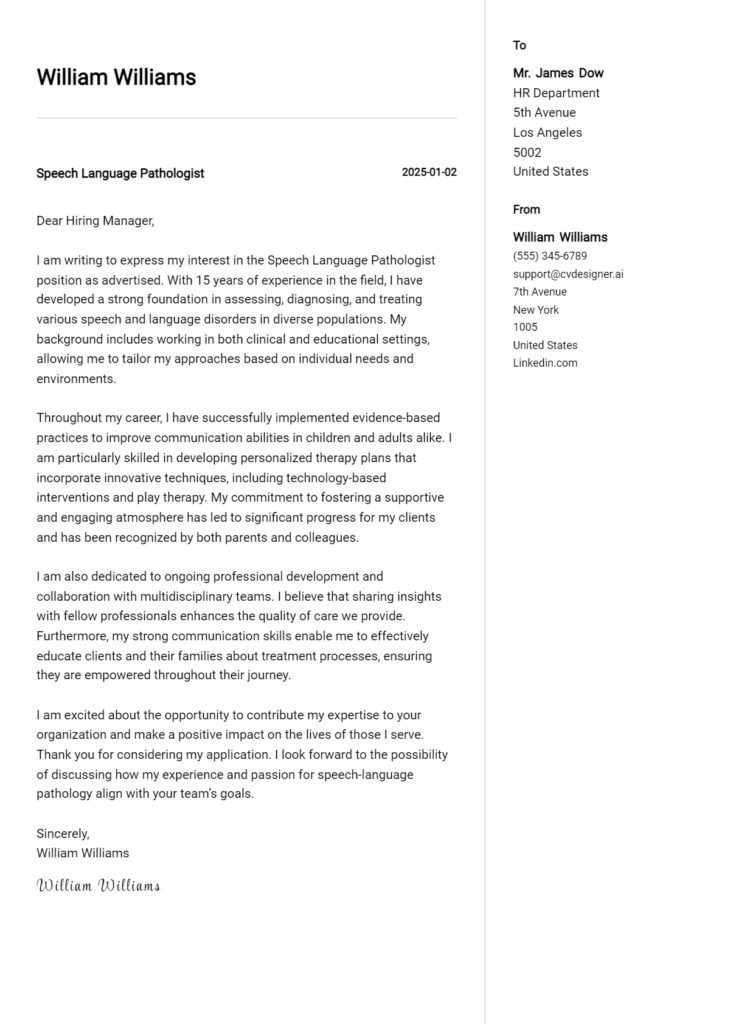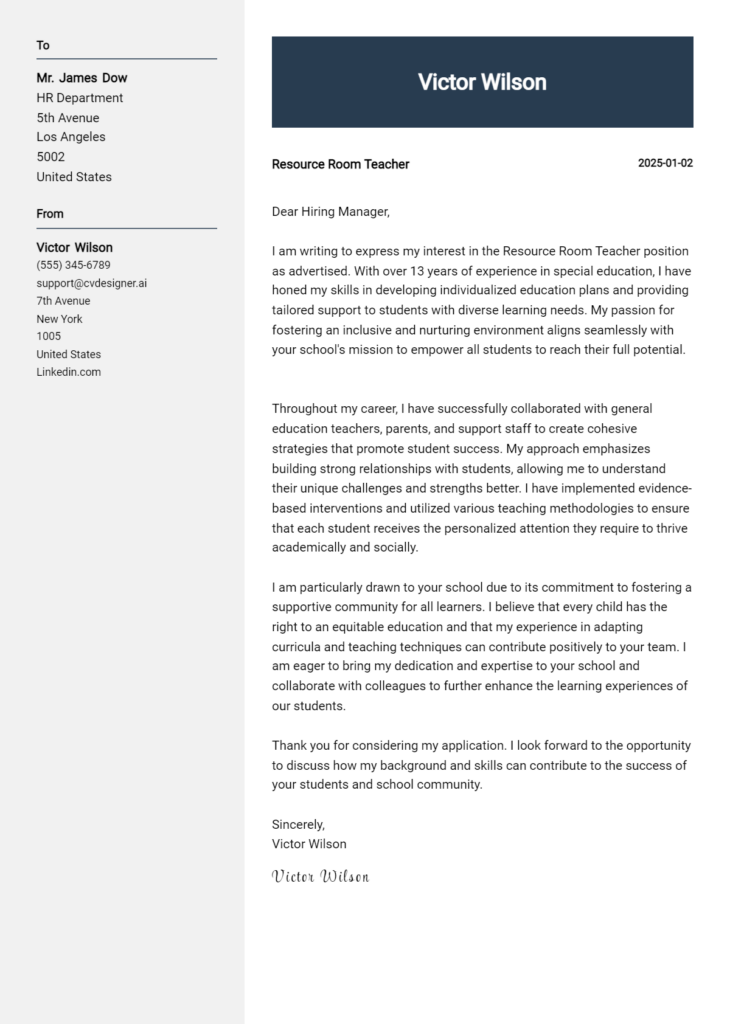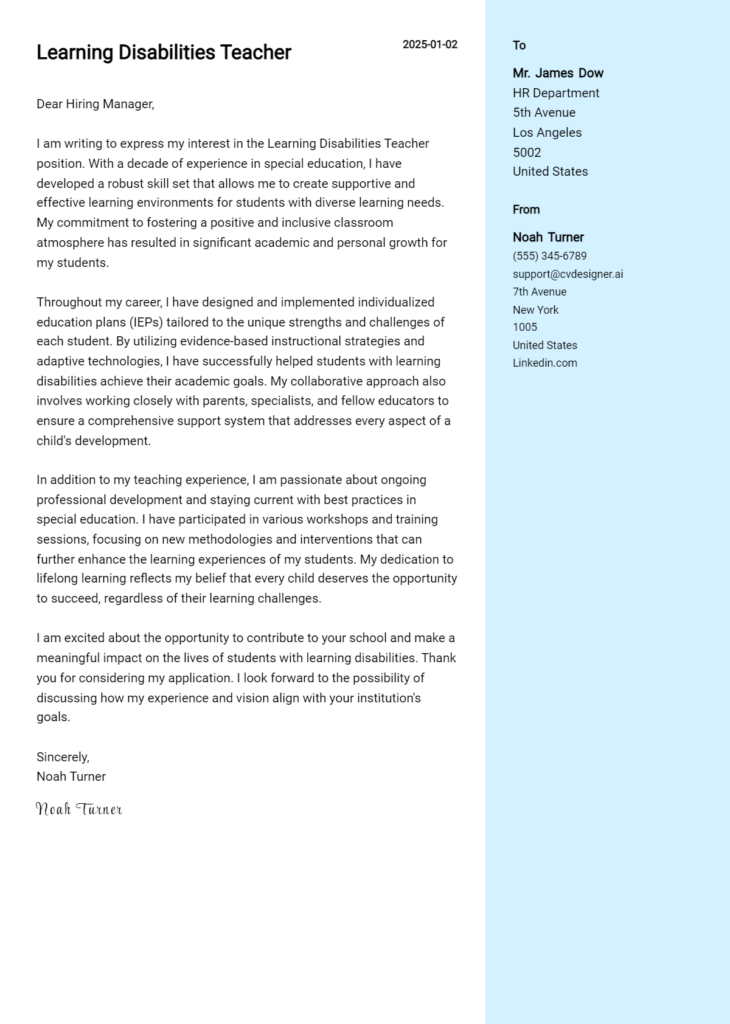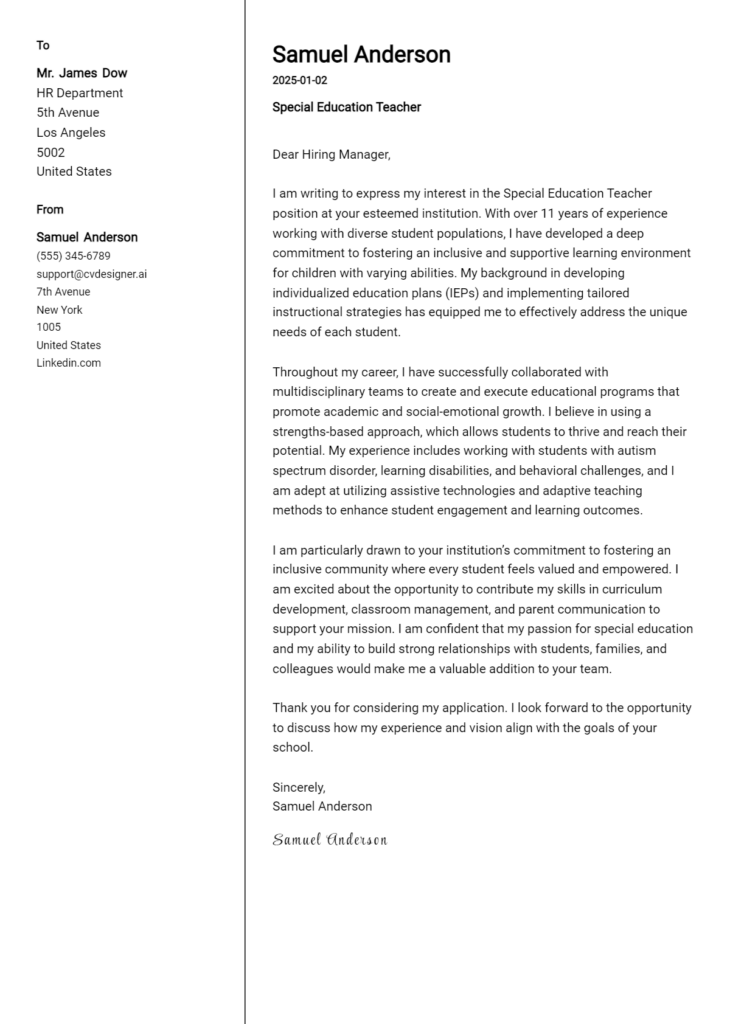Occupational Therapist Cover Letter Examples
Explore additional Occupational Therapist cover letter samples and guides and see what works for your level of experience or role.
How to Format an Occupational Therapist Cover Letter
Crafting an effective cover letter is essential for occupational therapists, as it serves as your first opportunity to communicate your qualifications and passion for the role. Proper formatting not only ensures clarity but also reflects your professionalism and understanding of the healthcare field. A well-structured cover letter can engage the hiring manager and highlight your commitment to patient care and rehabilitation—critical aspects of occupational therapy.
In this guide, we’ll outline the key components of a professional cover letter, providing insights and occupational therapy-specific examples to help you create a compelling document.
We will focus on the essential elements of a standout cover letter, including:
- Cover Letter Header
- Cover Letter Greeting
- Cover Letter Introduction
- Cover Letter Body
- Cover Letter Closing
Each section is vital for showcasing your skills and dedication to helping others. Let’s explore how to make your occupational therapist cover letter shine.
Importance of the Cover Letter Header for an Occupational Therapist
The header of a cover letter is crucial as it sets the tone for the document and provides essential information that facilitates communication between the applicant and potential employer. A well-structured header not only reflects professionalism but also ensures clarity, making it easy for hiring managers to identify the applicant's details at a glance. The header should include the applicant’s contact information (name, phone number, email address), the date, and the recipient's details (hiring manager's name and title, organization, and address). A strong header conveys attention to detail, which is an important quality for an Occupational Therapist who often works with clients in need of precise care and support.
Strong Example
Jane Doe 123 Health Lane Wellness City, ST 12345 (123) 456-7890 janedoe@email.com October 15, 2023 Mr. John Smith Director of Human Resources Wellness Therapy Center 456 Care Ave Healing Town, ST 67890
Weak Example
Jane (123) 456-7890 janedoe@email.com 10/15/23 To Whom It May Concern
The Importance of a Strong Cover Letter Greeting for an Occupational Therapist
The greeting of your cover letter serves as the initial point of contact with the hiring manager and is crucial in setting the tone for the remainder of your correspondence. A well-crafted greeting conveys professionalism and demonstrates that you have taken the time to personalize your application. Addressing the hiring manager directly not only engages them but also shows your genuine interest in the position. To enhance your greeting, it is advisable to avoid generic phrases such as "To Whom It May Concern." Instead, take a moment to research the recipient’s name and title, which can often be found on the organization's website or through professional networking platforms. This effort not only reflects your attention to detail but also helps establish a connection with the reader.
Here are examples of strong and weak greetings for an Occupational Therapist cover letter:
Strong Greeting Example:
Dear Ms. Smith,
Weak Greeting Example:
To Whom It May Concern,
Importance of a Well-Crafted Cover Letter Introduction for an Occupational Therapist
A well-crafted cover letter introduction is crucial for an Occupational Therapist as it sets the tone for the entire application. This opening paragraph should not only capture the hiring manager's attention immediately but also express the candidate’s enthusiasm for the role. Additionally, it should briefly highlight key skills or achievements that align with the job requirements, demonstrating the candidate's value and fit for the position. A strong introduction can differentiate a candidate from the competition, making it essential to get it right.
Strong Example
Dear [Hiring Manager's Name], I am thrilled to apply for the Occupational Therapist position at [Company Name], where I can combine my passion for enhancing patients' quality of life with my extensive experience in rehabilitative care. With over five years of specialized experience in pediatric therapy and a proven track record of developing individualized treatment plans that have led to significant improvements in patient outcomes, I am eager to contribute to your team and support your mission of fostering independence and well-being in all clients.
Weak Example
To Whom It May Concern, I am writing to apply for the Occupational Therapist job. I have some experience in the field and think I would be a good fit. I have worked with patients before and can help with therapy.
Purpose of the Cover Letter Body for an Occupational Therapist
The cover letter body for an Occupational Therapist serves as a crucial platform for candidates to articulate their unique skills, experiences, and the value they can bring to the organization. This section allows applicants to highlight specific projects or accomplishments that demonstrate their expertise in improving patients' quality of life through tailored therapy programs. A well-crafted cover letter body not only showcases the therapist's professional journey but also connects their personal commitment to patient care with the mission and values of the prospective employer. By detailing relevant experiences and successes, candidates can effectively distinguish themselves in a competitive job market.
Strong Example
Dear [Hiring Manager's Name], I am excited to apply for the Occupational Therapist position at [Company Name]. With over five years of experience in pediatric therapy, I successfully developed and implemented a sensory integration program that improved the developmental milestones of 85% of the children in my care. Collaborating with multidisciplinary teams, I also led a project that integrated technology into therapy sessions, significantly increasing engagement and participation among my clients. My passion for empowering individuals through tailored therapeutic interventions aligns perfectly with [Company Name]'s commitment to holistic patient care. Sincerely, [Your Name]
Weak Example
Dear [Hiring Manager's Name], I am writing to express my interest in the Occupational Therapist position. I have worked as an occupational therapist for a few years and have helped many patients. I believe I can do a good job at [Company Name]. I like working with people and helping them feel better. I hope to bring my experience to your team. Best, [Your Name]
The Importance of a Cover Letter Closing for an Occupational Therapist
The closing paragraph of a cover letter serves as an essential opportunity to reinforce your qualifications, express enthusiasm for the role, and prompt the hiring manager to take action, such as reviewing your resume or scheduling an interview. A strong closing can leave a lasting impression and convey your professionalism and eagerness to contribute to the team. In contrast, a weak closing might fail to convey your genuine interest or lack clarity about the next steps, potentially diminishing your chances of being considered for the position.
Strong Example
Thank you for considering my application for the Occupational Therapist position at [Company Name]. With my extensive experience in developing tailored treatment plans and my passion for helping patients achieve their goals, I am excited about the opportunity to contribute to your team. I look forward to discussing how my skills and background align with the needs of your clinic. Please feel free to contact me to schedule an interview at your earliest convenience. Thank you once again for your time and consideration.
Weak Example
I hope to hear from you soon. I think I would be a good fit for the Occupational Therapist job. Please look at my resume. Thanks.
Crafting an effective cover letter is essential for Occupational Therapist candidates looking to stand out in a competitive job market. A well-written cover letter not only introduces you to potential employers but also allows you to showcase your technical skills, problem-solving abilities, knowledge of the service delivery and life cycle (SDLC), teamwork experience, and passion for continuous learning. By highlighting these attributes, you can demonstrate your suitability for the role and your commitment to providing high-quality care to patients.
Tips for Writing an Effective Occupational Therapist Cover Letter
Highlight Your Technical Skills
Emphasize your expertise in therapeutic techniques, assessment tools, and documentation processes. Use specific examples to showcase how your technical skills have positively impacted patient outcomes. This can include familiarity with assistive technology, adaptive equipment, or therapeutic modalities relevant to the role.Showcase Problem-Solving Abilities
Occupational therapy often requires creative problem-solving to address patients' unique needs. Share a brief anecdote that illustrates your ability to assess challenges and develop effective treatment plans. Highlight your critical thinking skills and how they have led to successful interventions.Demonstrate Knowledge of SDLC
Understanding the service delivery and life cycle is crucial for occupational therapists. Discuss your experience in the different phases of client engagement—from evaluation to treatment planning and outcome assessment. Mention any relevant frameworks or models you are familiar with, which can reassure employers of your comprehensive approach.Emphasize Teamwork Experience
Collaboration is key in healthcare settings. Describe your experience working within interdisciplinary teams, emphasizing your role in coordinating care and supporting other professionals. Highlight how effective communication and teamwork have contributed to improved patient care and outcomes.Express Passion for Continuous Learning
The field of occupational therapy is constantly evolving, and employers value candidates who are committed to professional growth. Mention any continuing education courses, certifications, or workshops you have attended. Express your enthusiasm for staying current with best practices and integrating new techniques into your therapy sessions.
By incorporating these tips into your cover letter, you can create a compelling narrative that makes a strong case for your candidacy. If you’re looking for inspiration, check out some cover letter templates or utilize a cover letter builder to streamline the process.
Common Mistakes to Avoid in a Occupational Therapist Cover Letter
Crafting a compelling cover letter is essential for occupational therapists aiming to stand out in a competitive job market. Avoiding common mistakes can significantly enhance your chances of making a positive impression. Here are some frequent pitfalls to watch out for:
Generic Content: Many applicants use a one-size-fits-all approach. Tailor your letter to the specific role and organization to show genuine interest.
Focusing on Job Duties: Instead of listing your responsibilities, highlight your achievements and how they benefited clients. Use quantifiable results when possible.
Neglecting Formatting: A poorly formatted cover letter can be off-putting. Follow a professional cover letter format to ensure clarity and readability.
Spelling and Grammar Errors: Typos can undermine your professionalism. Always proofread your letter or use tools to catch mistakes.
Lack of Personal Connection: Failing to connect your experiences with the company's mission can make your letter forgettable. Research the organization and align your values with theirs.
Overly Formal Language: While professionalism is important, overly formal language can come off as stiff. Aim for a conversational tone that reflects your personality.
Ignoring the Call to Action: Many applicants forget to include a strong closing that invites further discussion. End with a call to action that expresses your enthusiasm for an interview.
By steering clear of these common mistakes and referring to cover letter examples, you can create a powerful cover letter that showcases your skills and sets you apart from the competition.
Cover Letter FAQs for Occupational Therapist
What should I include in my cover letter as an Occupational Therapist?
In your cover letter, you should include your relevant qualifications, specific skills, and experiences that make you a strong candidate for the Occupational Therapist position. Begin with a brief introduction, stating your current role and your passion for occupational therapy. Highlight your education, including your degree and any certifications, and discuss your clinical experience, emphasizing any specialties like pediatrics or geriatrics. Don’t forget to mention your soft skills, such as communication and empathy, which are crucial in this field. Tailor your cover letter to the job description, demonstrating how your background aligns with the employer's needs. Finally, express your enthusiasm for the opportunity and your commitment to improving patient outcomes.
How can I make my cover letter stand out?
To make your cover letter stand out, focus on personalization and storytelling. Address the letter to a specific person, if possible, instead of using generic greetings. Use compelling anecdotes that highlight your achievements, such as a successful intervention or a significant impact on a patient's recovery. Incorporate keywords from the job description to show that you understand the role and can meet its requirements. Additionally, showcase your unique approach to therapy and any innovative techniques you've employed. Lastly, ensure your letter is well-organized and free from errors, as professionalism is key in the healthcare field.
How long should my cover letter be?
Your cover letter should typically be one page long, consisting of three to four paragraphs. Aim for around 250 to 400 words. This length allows you to concisely convey your qualifications and enthusiasm without overwhelming the reader. Start with a strong opening paragraph that captures attention, followed by a middle section detailing your relevant experiences and skills. Conclude with a closing paragraph that reiterates your interest in the position and invites the employer to contact you for an interview. Remember, clarity and brevity are essential; hiring managers appreciate a focused and direct presentation of your qualifications.
Should I include my salary expectations in my cover letter?
It is generally advisable to avoid including salary expectations in your cover letter unless the job posting specifically requests this information. Instead, focus on showcasing your qualifications and enthusiasm for the role. If asked during an interview or if the employer brings it up, be prepared to discuss your salary expectations based on your experience, industry standards, and the specific responsibilities of the position. If you feel it's necessary to mention salary in your cover letter, do so briefly and frame it in a way that emphasizes your flexibility and willingness to negotiate, rather than presenting a fixed figure.
Build your Cover Letter in minutes
Use an AI-powered cover letter builder and have your letter done in 5 minutes. Just select your template and our software will guide you through the process.

